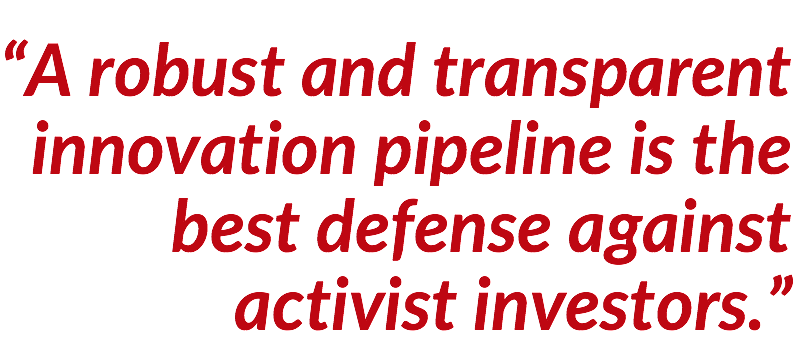Today companies innovate to grow their core business or break into new markets, with the aim of differentiating themselves against competitors. By creating new product categories, business models, or solutions to problems that otherwise stymie development, innovation efforts can yield substantial returns. Of course, they also require a great deal of resources—plus patience and stamina for the time it often takes to develop ideas into marketable breakthroughs. As an investment in the future, innovation demands that corporate leadership have a long view.
But as many innovation managers know, executives often take a more cautious and conservative approach to change, with some being downright skeptical. Few are as hostile, however, as a rising new breed of corporate shareholders: activist investors. As individuals or groups that buy a large equity stake in a company with the goal of effecting major change, activist investors often get deeply involved in governance by advocating new business strategies or attacking existing ones. Motivated by short-term profitability, these investors focus their efforts solely on raising stock value and pay out more to shareholders. And they’ll lobby for whatever it takes to achieve their aims—even if it means forcing an abrupt change in leadership, as the world witnessed with the ousting of GE’s former CEO, Jeff Imelt.
Corporate innovation teams already face challenges in garnering the resources they need and demonstrating the value of their efforts to leadership. But no internal tensions that might result from that compare to the all-out threat that activist investors pose. Seen by many as hostile to long-term growth strategies with a broader view of progress, these investors harken back to the corporate raiders of the 80s, stopping at nothing in the name of profits. Some innovation leaders we’ve spoken with have even suggested they’re sheer predators. After all, the selfish greed that motivates them flies directly in the face of human progress and betterment that innovation inspires and often promises.
Key to Survival: Discipline and Accountability
But while the threat is looming, death isn’t inevitable. Innovation programs are not created or managed equally, and therefore not all prey to the attack-and-kill tactics of activist shareholders. The key is for an innovation team to build a defensive posture preemptively. And that, says entrepreneur and academic Steve Blank, lies in discipline and accountability:
“Companies and government organizations are discovering that innovation activities without a defined innovation pipeline result in innovation theater. And an innovation pipeline needs to be driven with speed and urgency and results measured by the impact on the top and bottom lines.”
Many innovation program and lab managers fall into the trap of believing that because the innovation process takes time and may never yield a breakthrough, that they’re somehow exempt from regulating themselves and producing results. They might even presume carte blanche. But without a system of accountability, a program or lab will quickly consume a great deal resources with little or anything to show for it.
While corporate leadership might not demand immediate results or question accountability, outside forces ultimately will. Investors with a short-term agenda won’t wait around for the validation of innovation efforts. They only care about the bottom line and will stop at nothing to boost it.
 Though there are no guarantees, the way to minimize the impact of activist investors’ predatory tactics, according to Blank,
Though there are no guarantees, the way to minimize the impact of activist investors’ predatory tactics, according to Blank,
is to articulate and implement “a self-regulating, evidence-based innovation pipeline.” Such a pipeline should “help innovators and other stakeholders to curate and prioritize problems, ideas, and technologies” at the outset; develop and test them with empirical data; and then consistently track, measure, and report on outcome success and financial benefit. This kind of pipeline will imbue any corporate innovation program or lab with rigor and accountability, giving it substantially more protection against the immediate-profit motives of short-sighted shareholders.
An innovation program or lab is protected even further against activist investors when it’s part of what Harvard professor Bill George has called a larger, clearly focused corporate strategy. In the context of such a strategy, an innovation pipeline represents an integral part of a larger vision, making it more difficult to dislodge. Taking this thinking even a step further, BlackRock CEO Larry Fink has spoken of “profits with a purpose,” where the corporate strategy in question is oriented around a greater good. The best companies, says Fink, are those that work towards a purpose. Doing so “unites their employees, connects their clients, but most importantly brings the organization onto a common plane.”
Many would assert that with its vision of human progress, innovation qualifies as a noble purpose. The challenge for any company involved in it is to ensure its innovation efforts are integrated into a broader corporate vision.
At Brightidea, our focus is on helping organizations to build a self-sustaining innovation pipeline—one that’s more easily integrated with a larger strategy. With capabilities to curate and prioritize ideas and solutions, develop and test them, and track and measure the progress and success of every outcome, such a pipeline bolsters an innovation program or lab with the rigor and accountability necessary to validate its efforts. After all, only with this kind of structure can corporate innovation be protected from the short-termism that otherwise threatens its existence.


